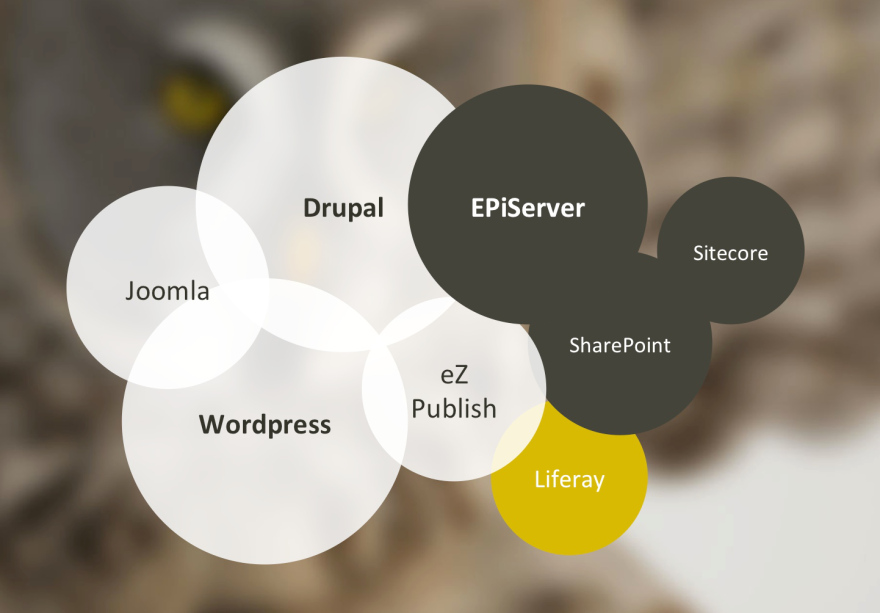This article lists the most significant international content management systems in Finland. The list includes systems which are suitable for both large-scale websites and intranets. Other international products are also used in Finland, but this list includes only those with several integrators or very significant implementations.
North Patrol is a consulting firm specialized in the design of digital services and information systems. We shape ideas into a vision and service concept, find the best architectural and technological solutions, design a functional user experience, and compete to find the ideal partner for implementation work. We do not sell implementation projects, nor do we sell licenses; we are genuinely on the side of the customer.

This article is a part of CMS selection article series by North Patrol.
North Patrol helps customers to make smart technology decisions and find the best implementation partners. Typically, we facilitate prestudy projects and evaluate vendors and proposals. Most of our clients are large companies headquartered in Finland.
The order of the systems listed is based on an estimate of how commonly they are used as platforms for medium-sized and large projects. This article describes the use for which each system is best suited, and its use in Finland in particular.
Drupal
Drupal is an open source web CMS which is used as a platform for many customised web applications. Firms and individual vendors with Drupal skills are fairly common in Finland, but their skill sets are also very much in demand. In Finland, Drupal is used as a platform for the websites of several media outlets (e.g. Nelonen, Uusi Suomi), but also as a platform for smaller sites - although it is not particularly agile for smaller implementations. Drupal’s strengths are that it can be customised and has a wide community. As a web publishing product Drupal does not have any particular strengths or clear areas of specialisation because the system is primarily designed for notably tailored websites (e.g. web communities like extranets or electronic services). There are a few IT companies in Finland which specialise in Drupal, such as Wunderkraut, Drupro, Exove, Brain Alliance and Activeark. In addition, many website design firms have produced their own "packages" using Drupal with which they can produce websites quickly and cost-effectively. Overall, Finland already has several thousand websites implemented using Drupal. The cost of Drupal web projects usually begins at about 20,000 euros, but projects best suited to Drupal generally cost more than 100,000 euros.
- Best feature: Huge ecosystem of add-ons, particularly for web publishing.
- Main drawback: Has no clear "product features", as most projects are compiled using different set of modules.
EPiServer
EPiServer is a Swedish CMS product, which is especially popular there and elsewhere in Europe. EPiServer has established a strong position in recent years, and already has several dozen partners who use the product to implement websites. One notable feature of EPiServer is that hosting is almost always purchased directly from EPiServer, so changing IT vendors is easier. Well-known domestic EPiServer customers include Orion, Kesko and Suunto. EPiServer has a small office in Finland, and global support is available in Finnish. Projects implemented using EPiServer usually cost from 30,000 to 70,000 euros. Although EPiServer is most suitable for projects with a budget in the 100,000 euro range. EPiServer also has an e-commerce extension and a community extension.
- Best feature: Commodified, diverse CMS with a clear hosting model.
- Main drawback: Licenses often consume a large part of the budget in projects of less than 50,000 euros.
WordPress
In recent years WordPress has established its position as the world’s most popular blog platform. Wordpress is an open source CMS based on the PHP programming language. Wordpress is also used as a CMS for growing amount of small and medium-sized websites. Even so, WordPress is still primarily a publication-oriented platform, and is usually an ideal solution only for newspapers and other media outlets. Finland has many WordPress experts but few who specialise in it, even among medium-sized vendors. Nevertheless, thanks to an extensive global community and plugin market, one person can produce impressive medium-sized websites. Wordpress is very popular with advertising agencies and website design firms for affordable website implementations. Website projects using WordPress generally cost less than 5,000 euros, but it is also used for projects of more than 10,000 euros. Examples of vendors: Arkimedia, H1, Exove, Wysiwyg. There are several thousand sites created with WordPress in Finland alone.
- Best feature: Low learning curve and use threshold.
- Main drawback: Limited application for larger websites mainly due to lack of specialised support.
Joomla
Joomla is an open source CMS and has been a leading CMS worldwide for many years. In Finland, it has been used extensively by advertising agencies and website design firms, but many have now switched to WordPress, Drupal or SilverStripe. However, Joomla still has a strong position in Finland, particularly as a CMS for small, informational websites. Active Joomla users in Finland include many associations and political parties. In fact, Joomla may even be Finland’s most popular CMS, and has been used to implement several thousand sites in the past decade. Like Drupal and WordPress, Joomla is a CMS based on PHP technology. Unfortunately, while there is a great deal of expertise in Finland, only a few vendors have specialised in the system. The average price of a Joomla project varies from 2,000 to about 10,000 euros. In Finland, typical Joomla vendors are solo web designers and IT consultants working alone.
- Best feature: Cost effective solution for informational websites.
- Main drawback: During the last few years, the number of partners in Finland has fallen dramatically.
SharePoint
SharePoint is Microsoft’s portal system, which can also be used as a CMS. In Finland, SharePoint has achieved a strong position as an intranet platform. SharePoint is also used as a website platform, but the system is not specifically designed for web publication so IT firms which sell it usually offer another product as a CMS (e.g. EPiServer, Sitecore or their own product). SharePoint’s high license costs are its most significant drawback. SharePoint’s typical users are large organisations implementing very extensive websites on top of SharePoint. For example Fortum's website is built on SharePoint. There are hundreds of SharePoint experts in Finland and the system is sold by several dozen domestic IT companies. Microsoft Finland also offers support for SharePoint projects. However, firms specialising in SharePoint usually have limited website experience, so concept design expertise should be requested separately. The cost of web projects using SharePoint often start at 60,000 euros because of particularly high license fees. The system has been developed mainly from an intranet point of view, so its features make website projects more difficult than its competitors. In practice, SharePoint website projects fall into the range of more than 100,000 euros. Although licensing is fundamentally different for intranet projects, and the system’s features are also better suited for intranet implementations. The cost of an intranet project using SharePoint starts at 30,000 euros or even less.
- Best feature: Robust and cost-effective intranet platform, which can also be used for document management.
- Main drawback: High license costs and more difficult project implementation than its competitors.
Liferay
Liferay is an open source CMS based on Java technology. Liferay was originally a portal system, which later started to be used as a CMS. Liferay has been used in Finland on particularly large projects because the software belongs to the "heavyweight" series. In Finland it has a reputation for being a little sluggish, but in recent years a handful of integrators has emerged who use Liferay, to design and implement a wide range of website solutions. Liferay is typically used for extranet solutions and other tailored websites which require users to log in. Particularly in the financial sector Liferay is considered a somewhat more agile alternative to Oracle’s and IBM’s heavy portal products. Extranet services and customised websites implemented with Liferay generally cost about 100,000 euros or more. Offering a community "basic version" and a commercially supported Enterprise version is one of Liferay’s distinguishing features. To some degree this also affects the focus of various integrators. Examples of integrators: Ambientia, Arcusys, Proactum, Logica, Ixonos and Samcom.
- Best feature: Liferay can be integrated well with many Java systems, which can be a significant advantage particularly in demanding extranets.
- Main drawback: Liferay is definitely not a "web publishing product" but a portal which is always built on a customer-specific basis.
eZ Publish
eZ Publish from Norway is an open code CMS, but development is tightly controlled by its Norwegian parent company. The software is a rare combination of open source code and a strong corporate entity behind the system. The system has a few expert integrators in Finland, and competes primarily with domestic CMS products. Finnish organisations which have implemented public websites using the system include Fiskars, The Federation of Finnish Commerce and Sanoma Magazines (e.g. Tietokone.fi). The cost of medium-sized eZ Publish web projects in Finland usually starts at about 20,000 euros, but large sites can cost close to 100,000. Examples of integrators: NXC Finland, Exove.
- Best feature: Diverse built-in features.
- Main drawback: Not much expertise in Finland.
Sitecore
Sitecore is a Danish CMS which competes in Europe with systems such as EPiServer but is used around the world. Sitecore is a somewhat heavier weight CMS, and its licensing and business partners also focus on implementation of extensive marketing and sales websites. Sitecore clearly differs from systems including EPiServer in that it requires significantly more initial effort. Sitecore is based on the .Net framework and is compatible with Microsoft systems. In recent years Sitecore has done very well in various comparisons, but is still not common in Finland, probably due in part to its high license fees. The cost of website projects implemented using Sitecore is in the 100,000 euro range. In Europe, Sitecore generally competes with products like Adobe CQ5 CMS for large multilingual website projects. In Finland the only vendor which competes with Sitecore is AtBusiness.
- Best feature: Very high quality "marketing machine" features.
- Main drawback: Very heavy product with limited expertise in Finland.
Confluence
Confluence is a wiki product from the Australian software firm Atlassian, which has already been a leading player in its own category for years. As a wiki platform, Confluence is extremely versatile and even competes in the intranet sector with SharePoint. For example, Finnair's and Aalto University's intranet services have been implemented using Confluence. Universities and polytechnics have also used Confluence for public and community websites. For example Aalto University’s extensive Into website for students was implemented using Confluence. However, Confluence is not a traditional CMS, but is focused primarily on sites which require users to log in. Confluence is one of the most common and highest quality systems in the world for large knowledge bases and community-based project sites, and is generally used for them in Finland, as well. There are a number of skilled Confluence integrators in Finland, but for developers the Java-based system has a somewhat steep learning curve. However, Confluence has a large ecosystem of plugins and extensions so customisation is only rarely needed. Software companies in Finland which focus on Confluence include Ambientia and Polar Shift. License costs are a few thousand euros, and implementation projects are usually 10,000 to 50,000 euros.
- Best feature: Active product development focused particularly on end-users.
- Main drawback: Weak document management, which is a particular problem in intranet use.
SilverStripe
SilverStripe is a PHP-based CMS from New Zealand which has made inroads in Finland in the past couple of years. SilverStripe competes primarily with domestic CMSs, Joomla and WordPress. SilverStripe is particularly well suited for implementation of informational websites, making it somewhat similar to CMSs like Joomla. Unfortunately there are only a handful of people working with SilverStripe in Finland. Typical SilverStripe projects are websites in a price range of less than 20,000 euros. Examples of website design firms implementing SilverStripe: Aucor, Barabra, Flo Apps, Recommended.
- Best feature: Somewhat more diverse and modern than Joomla, and even a challenger to WordPress.
- Main drawback: Only a small group of experts in Finland, and still not nearly as popular as Joomla and WordPress.
Typo3
Typo3 is an open source code PHP-based CMS which is in a slightly heavier class of systems, along with Drupal. In Europe Typo3 is a popular CMS among universities. Development of Typo3 began in Denmark in the 1990s. A few Finnish firms use Typo3, and a significant number of domestic PHP-developers are available. Projects implemented using Typo3 generally cost more than 30,000 euros. Users of Typo3 in Finland include Mediasignal Communications.
- Best feature: Extensive features for web publishing.
- Main drawback: Very limited expertise in Finland.
Plone
Plone is an open source CMS with a very long development history. Plone users include large organisations around the world. One of the most significant Finnish users of Plone is the University of Jyväskylä (www.jyu.fi), and there are other Plone users in the higher education sector, as well (e.g. CSC). There are only a handful of Plone experts in Finland, in part because it was developed in a slightly less common language, Python, and on the Zope web application server. In other parts of Europe, for instance, the Plone CMS has become quite a success story. The cost of implementing Plone typically varies from 30,000 to 100,000 euros.
- Best feature: Extensive features for web publishing. Well-suited for multi-site management.
- Main drawback: Only a few experts in Finland.
Escenic
Escenic is a Norwegian CMS especially designed for media houses. It is now owned by Vizrt, a content production tool provider specialising in applications for television broadcasting companies. Escenic is a Java-based CMS and content engine designed to meet the needs of hectic media houses. For example, Finland's national broadcasting company YLE News is using Escenic CMS as the platform for their online news production. Other Escenic users in Finland include the newspaper Keskisuomalainen, the Talentum Group’s website and other Talentum publications (such as Tietoviikko). The implementation costs of those web projects no doubt reached six figures. The Finnish IT provider Avoltus specialises in Escenic solutions and also Solita has done projects on the platform.
- Best feature: Designed for publishing online articles and multimedia as one large data stream.
- Main drawback: The system has a reputation for being inflexible.
WebSphere Portal
IBM’s WebSphere Portal is currently being used by a few large Finnish organisations (e.g. the City of Helsinki, the Finnish Defense Forces and the leading department store Stockmann). However, the IBM portal software family does not enjoy a particularly good reputation in web content management,so IBM portal customers are mostly companies in the online store sector, where the IBM product line’s strengths lie. Finnish companies integrating IBM portal solutions into their services include Descom and Ambientia. Typical online store projects running on IBM platforms cost six or even seven figures. Oracle WebCenter Suite and Liferay are direct competitors for IBM portal software. Liferay in particular has become significantly more popular in the past few years, clearly decreasing interest in IBM in the portal market. In 2012, IBM can be recommended mainly for extensive online store projects, and even then with caution.
Fatwire (Oracle)
Fatwire, now owned by Oracle, is a heavyweight CMS. Fatwire is used for web solutions worldwide, especially by international brands. Projects implemented with this system all invariably cost six to seven figures, since system licences alone can easily cost more than the typical cost of an entire implementation project in Finland. The lack of skilled Fatfire CMS integrators in Finland makes this system an uncommon choice. Nevertheless, a few large groups have used Fatwire in Finland in the past. Alma Media is among the current Finnish Fatwire clients. For example Aamulehti runs on Fatwire. Owned by Oracle, Fatwire is now a part of the Oracle WebCenter Suite, called WebCenter Sites. Given the stormy past of Oracle CMS solutions, in 2012 we would recommend Fatwire only to Finnish clients willing to take big risks.
WebCenter Suite (Oracle)
The Oracle product family has included several slightly overlapping systems in the past few years. For this reason, Oracle WebCenter Content (= UCM / ex-Stellent) is used as a web content management system in some sectors, and as an information management system in others (e.g. as a content engine or for document management). For example, the Tampere University of Technology’s website runs on Oracle UCM. The University of Helsinki has chosen an architecture combining the Oracle WebLogic Portal and Oracle UCM. In addition, a number of companies in the financial sector use WebCenter Suite products. WebCenter Suite cannot be considered a typical CMS, although it is sometimes used as one. While WebCenter Content has been a CMS, Oracle has hardly developed its' web publishing features at all in the past few years. WebLogic Portal is regarded more as a platform for electronic services, and is used in environments requiring very high capacity. Typical WebCenter Suite projects have a six-figure price tag even in Finland, and usually need to be tailored for each customer. IT providers using the Oracle portal family include Digia and Accenture. Companies in the financial sector often choose Oracle because they already use Oracle CRM systems, which are compatible with WebCenter Suite products. Our opinion of other Oracle products is the same as of Fatwire: Recommended only for clients willing to take big risks and with plenty of money.
Other international products
There are plenty of single examples of clients using heavyweight CMS products in Finland. Nokia.com is currently running on a German CMS system by CoreMedia, and there are other users of individual, large-scale products, as well. The purpose of this article, however, was to comprehensively cover products which play a noteworthy role in Finland.
Final notes:
The predominant medium-weight systems used in Finland include Drupal and EPiServer. Very few projects in Finland each year require features these systems cannot provide. The strong position of these systems is also rooted in a strong network of integrators. Among lightweight solutions, WordPress has gained more attention in 2012.


